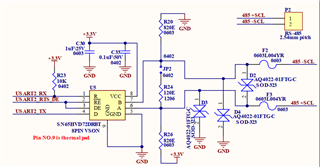Hi team,
We have designed an RS485 device that will act as a slave device, as per the attached schematic,
Please suggest your inputs on the bus termination resistor R20 and R26, and their overall impact on the network when ~32 devices are connected to the network, should we mount that resistor or not?

Is our Termination resistor topology creating this stability issue? What will be the appropriate Termination Resistor Placement method as per RS-485 Guidelines in such type of networks?
What is the most appropriate value for the termination resistors on the network?

